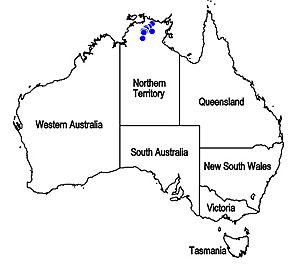Pityrodia gilruthiana facts for kids
Quick facts for kids Pityrodia gilruthiana |
|
|---|---|
| Scientific classification | |
| Genus: |
Pityrodia
|
| Species: |
gilruthiana
|
 |
|
| Occurrence data from the ALA | |
Pityrodia gilruthiana is a special kind of flowering plant that belongs to the mint family, called Lamiaceae. You can only find it in a place called Arnhem Land in the Northern Territory of Australia. This plant is a dark green, spreading bush. Its branches and leaves feel sticky because they have tiny glands. It also has lovely, off-white, bell-shaped flowers with purple stripes. They smell nice too!
Contents
What Pityrodia gilruthiana Looks Like
Pityrodia gilruthiana is a bush that spreads out and can grow up to about 1.5 m (5 ft) tall. Its branches are sticky because they are covered in tiny, branched hairs that produce a sticky substance, like a natural glue.
The leaves of this plant are long and narrow, shaped like a spear. They are smooth but also sticky. Each leaf is about 8–25 cm (3–10 in) long and 2–4 mm (0.08–0.2 in) wide. The top side of the leaf is a darker green, and you can see a clear line, called a mid-vein, on the bottom side.
Its Unique Flowers
The flowers of Pityrodia gilruthiana are very fragrant and grow directly from the plant without a stalk. They appear where a leaf meets the stem, which is called a leaf axil. Each flower has a leaf-like part called a bract and smaller, sticky, linear bracteoles at its base, which are about 3–6 mm (0.1–0.2 in) long.
The flower has five sepals, which are like small leaves that protect the bud. They are about 7–10 mm (0.3–0.4 in) long and are joined together for less than half their length, forming a bell-shaped tube. At the end of this tube are five spear-shaped lobes. These lobes are about 4.5–7 mm (0.2–0.3 in) long, and they are hairy and sticky on the outside. The inside of the sepal tube is smooth.
The five petals of the flower are about 10–13 mm (0.4–0.5 in) long. They are joined together to form a tube that is almost cylindrical, about 6–8 mm (0.2–0.3 in) long. This tube is off-white with deep purple streaks on its upper part. The petals form two "lips": an upper lip with two lobes and a longer, lower lip with three lobes.
The outside, top part of the petal tube has soft hairs, but most of the rest is smooth. There is a ring of dense hairs just below the stamens, which are the parts of the flower that produce pollen. The lobes are somewhat egg-shaped. The upper lobes are 2–4 mm (0.08–0.2 in) long, and the lower ones are a bit longer and spread out more.
There are four stamens, and they stick out slightly beyond the end of the petal tube. The lower pair of stamens is a little longer than the other pair. This plant usually flowers from February to August. After flowering, it produces an oval-shaped, hairy fruit that is about 3–4 mm (0.1–0.2 in) long.
How Pityrodia gilruthiana Got Its Name
The plant Pityrodia gilruthiana was first officially described in 1979. It was named by a scientist named Ahmad Abid Munir. He studied a plant sample that was collected near Mount Gilruth in the Northern Territory.
The description of this new plant was then published in a scientific paper called Journal of the Adelaide Botanic Gardens. This is how new plants get their official names and become known to the scientific world.
Where Pityrodia gilruthiana Lives
This special plant, Pityrodia gilruthiana, grows in Arnhem Land. You can find it near Mount Gilruth, which is inside the Kakadu National Park. It also grows in areas like the Arnhem Plateau and the Pine Creek region. These are all part of the biogeographic regions of Australia.
Protecting Pityrodia gilruthiana
Good news! Pityrodia gilruthiana is currently classified as "least concern" under the Territory Parks and Wildlife Conservation Act 2000. This means that, for now, it is not considered to be in danger of disappearing.

